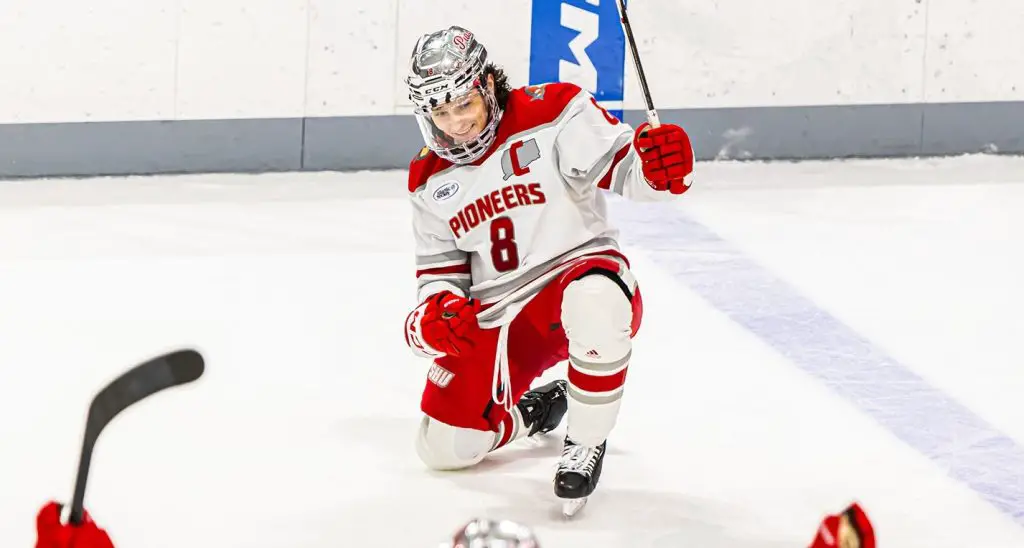
Each week during the season, we look at the big events and big games around Division I men’s college hockey in Tuesday Morning Quarterback.
Jim: Hello, Paula, and welcome back to TMQ as we are getting closer and closer to the end of this hockey season. It’s amazing to think that based on your program, there are only six or seven regular-season weekends remaining.
I think this past weekend we learned that the PairWise is a volatile animal right now. Boston College moved to No. 1 and lost that place in one night after a Saturday night loss to Providence. Wisconsin sat No. 2 and dropped to No. 5 without losing, simply tying (albeit a bottom PairWise team) Lindenwood.
But the most impacted team in the PairWise this weekend might have been Arizona State. The Sun Devils lost in OT and in regulation this weekend to Cornell at home. They dropped just one spot in the PairWise, from 16 to 17, but it may be a near-death sentence for ASU.
If Arizona State wins its last 12 games, they’ll finish at 28-5-5, yet still have a 23% chance of missing the NCAA tournament. And that’s IF they win 12 in a row to end this season.
The Sun Devils’ 28 wins would be the most ever to win and not make the tournament. Does this compute to you?
Paula: Well, what part of “this” do you mean?
Looking at Arizona State’s remaining schedule, the Sun Devils play no one ahead of them in the PWR, so even if they win out, their fate isn’t in their own hands. As unfair as that seems, it’s the case of so many bubble teams.
The Sun Devils are a very good team with a dynamic offense, a more-than-solid defense, and depth that should – theoretically – carry them into the NCAA tournament. Like a lot of hockey fans, I’ve been pulling for them all season. Arizona State is a team whose presence in the NCAA tournament starts some conversations about college hockey, and that heightened awareness of our sport is what we all want.
There are several good teams on that NCAA bubble who need a ton of help to reach the tournament. I understand your point about the number of wins – 28 and on the outside would feel especially unfair – but if Alaska wins out, the Nanooks would have 23 wins after a very solid season and still be watching the tournament at home while other teams with fewer wins would be participating.
Michigan, Cornell, Colorado College, Penn State and RIT are all teams that are hovering near that magic cutoff point and could be sitting this one out. Granted, each of those teams – all of which have the talent to advance in the tournament in spite of inconsistent seasons – has the chance to win a conference playoff championship for an autobid. That lack of opportunity for Arizona State and Alaska is the thing that doesn’t compute, at least not to me.
Watching seven teams play this season without conference affiliation has been, well, weird. I know that it would be no consolation at all to the Sun Devils if they don’t make the tournament, but the fact that they’re on the bubble at all given their schedule is evidence of the excellence of their program. They’ll be ready to step into the NCHC next season.
Which of course means nothing this year, I know – especially if they finish the season with more than 25 wins and are not tournament bound.
You started today with a mention of how little time remains in the regular season. As longtime USCHO readers know, my favorite hockey is conference playoff hockey. It’s been fun watching Michigan State and Wisconsin dominate the top of the Big Ten standings this season – always good to see programs that have been down a while re-emerge – and there are some tight races in several other conferences as well.
Hockey East isn’t as tight points-wise right now as it was at this time last year, but it still feels mighty competitive to me. Do you see the potential for a photo-finish there?
Jim: I’ll first address the Big Ten, and I think it’s somewhat remarkable how upside-down the standings feel to, say, two seasons ago. Wisconsin and Michigan State were in the cellar and now both seem like NCAA tournament teams. It shows how quickly things can turn around, particularly in a small league like the B1G.
As for Hockey East, I’m interested to see Boston University hold a solid grip at the top as I feel Boston College, Maine and Providence are all as solid in that conference. Going forward, other than the Beanpot, it’s mostly conference play for this league, so I expect a lot of cannibalization among the top of this league. I’m not even going to try to predict a champion.
Making a statement like that makes me think of another league – the CCHA. How can we predict a champion in that conference?
Right now, St. Thomas, a team that is ineligible for the NCAA tournament, leads the league. But Bemidji State, Lake Superior State and Minnesota State are all within a weekend sweep of first place and Michigan Tech lurks close in fifth place.
I think this might be the craziest conference race out there. No team is in a position for an at-large NCAA bid, so the conference tournament is all that matters. But what do you make of this league?
Paula: I’m so glad you brought up the CCHA. It’s insane.
And it’s insanely good hockey within conference play. It seems unfair to root against St. Thomas as the season progresses, but I do want to see the CCHA represented by the postseason conference championship in the NCAA tournament, and the only way that will happen is if someone other than St. Thomas wins the CCHA conference playoffs.
Sorry, Tommies. Really, I am.
What Enrico Blasi and his staff have done there in a short period of time is impressive. With their sweep of Michigan Tech last weekend, the Tommies now have 14 wins – the combined total of wins in their first two seasons under Blasi (if my math is right).
Six of the Tommies’ 10 remaining conference games are at home, but two of those series are against teams mere points behind them in the standings, Bemidji State and Minnesota State. St. Thomas ends the season on the road against another CCHA contender, Michigan Tech. The Huskies are in fifth place in the conference and nine points behind the Tommies.
Perhaps this competition will prepare the Tommies for a postseason run to a conference championship – but perhaps the same can be said for the top five teams in that league, especially when the difference between first place and fourth is just four points.
We don’t talk a lot about Atlantic Hockey, but that’s another conference that will see one team in the tournament with an autobid, in spite of the really good hockey being played right now by several teams in that conference.
Sacred Heart tops that conference with 34 points, six ahead of second-place AIC, but the Pioneers are 44th in the PairWise. The only team close to the PWR bubble is RIT, and the Tigers are No. 21.
But look at the competition in that conference. Seven points separate AIC from three teams tied for sixth place: Bentley, Canisius, Mercyhurst. Even after Mercyhurst, the drop-off in points is three, as Niagara has 18. That’s a lot of jockeying for playoff position as the season winds down, and just like I’m thinking with the CCHA, that’s good preparation for Atlantic Hockey postseason. I cannot begin to predict who will win that autobid.
Jim: Before I jump into the Atlantic Hockey situation, let me clarify one thing in the CCHA.
If St. Thomas were to win the conference tournament and the conference doesn’t have any team qualified for an at-large bid, which it likely won’t, the runner-up in that tournament would earn the conference’s bid.
As for Atlantic Hockey, throw a dart at a board right now. Sacred Heart is a surprise leader for me given how much they struggled out of conference. AIC and RIT feel like they should be the flag bearers, but you also remember how Holy Cross surged in the postseason last year. Canisius is always a powerhouse in the playoffs. Bentley has been great at times. Mercyhurst has a legend behind the bench in Rick Gotkin.
See what I mean about tossing a coin?
When you have teams like that, how do you handicap them? I love postseason experience and great goaltending. If you happen to have a fantastic power play, that’s a trifecta. Anything I miss if your opinion and what do you think teams need to get into the NCAA field?
Paula: Thanks for that clarification. I didn’t mean to muddy those waters.
And I certainly don’t want to invite hate mail from St. Thomas fans. Have at it, Tommies.
And yes, I see what you mean about tossing a coin – not just with Atlantic Hockey, but also with the NCHC.
Even Omaha – in sixth place with 11 points, 13 behind first-place St. Cloud – is a team that can threaten on any given night. The Mavericks have split with Western Michigan, Denver, Minnesota Duluth and most recently with North Dakota, plus to end the first half, Omaha lost to and tied league-leading St. Cloud, taking the extra point in the shootout.
St. Cloud State is two points ahead of second-place North Dakota, and the Fighting Hawks host the Huskies this weekend. Western Michigan – tied for third place with Denver, each with 17 points – hosts Minnesota Duluth, who is only five points behind the Broncos.
There is nothing predictable about this conference.
As for handicapping, I can’t even begin to guess, but I’m pretty sure it isn’t scoring alone. Look at Maine, though, as a cautionary tale. Until losing 2-0 to Connecticut Saturday, the Black Bears had scored three or more goals in their previous 10 and four or more in seven of those contests. In that span, Maine had allowed three or more goals four times and only one of those games was a loss.
One was a 5-3 win over Connecticut before that shutout loss and in their game immediately prior to that, Maine tied Colgate 4-4.
Then there’s Michigan, a team that averages 4.55 goals per game – bolstered, admittedly, by the Wolverines’ 19-goal output in a sweep of Stonehill last weekend – but Michigan struggles to score big in B1G play and is in fifth place in that conference. Last year, the Wolverines could rely on that offense to power them through nearly anything.
Is it goaltending? Boston University tops Hockey East and the PWR, yet Mathieu Caron is not among the top 10 goaltenders nationally in either save percentage or goals-against average. And Cornell’s Ian Shane is allowing 1.79 goals per game and look at where that team is in conference play and in the PWR.
Is it special teams? Wisconsin’s power play is 29th-best in the country, yet the Badgers are vying for the Big Ten title and are fifth in the PWR.
Regardless of “the” thing that will give a team an advantage going forward, one aspect that cannot be overstated is the importance of consistent overall team defense. A hot goalie down the stretch, a confident couple of lines that can be relied on to score – these will be assets to any team lucky to have them.
What I think we’ll see, though, is that teams that can solidify consistent, reliable overall team defense will prevail as the regular season plays on. I think that will be the difference in the tightest conference races.
And if that consistency doesn’t happen, we’ll definitely see a few interesting bumps and bruises in the PWR.


